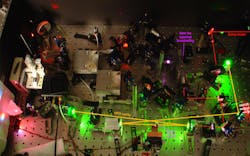Laser frequency comb enables high-level disinfection of harmful bacteria
The laser frequency comb is helping researchers at JILA, an institute operated jointly by the National Institute of Standards and Technology (NIST; Gaithersburg, MD) and the University of Colorado at Boulder, evaluate a novel instrument that kills harmful bacteria without the use of liquid chemicals or high temperatures.
Generated by ultrafast lasers, frequency combs precisely measure individual frequencies (colors) of light. The JILA researchers are using such a comb to identify specific molecules in gases based on which colors of light, or comb "teeth," are absorbed by the gas, and in what amounts. The comb measurements help explain for the first time how the researchers' sterilization technique inactivates bacteria, and will "help optimize solutions for the medical clinic where multi-drug-resistant bacteria are a growing problem," says Mark Golkowski, assistant professor of electrical engineering and bioengineering at the University of Colorado Denver.
Golkowski and the research team conducted a variety of tests with an instrument that delivers an air stream of free radicals to quickly kill bacteria up to 3 m away. The system achieved high-level disinfection of Staphylococcus aureus (which causes pneumonia and other diseases) and Pseudomonas aeruginosa (often found on medical equipment) on surfaces such as plastic ID badges—a major source of pathogen transmission. The method also proved effective against difficult-to-eradicate spores of Bacillus atrophaes (found in soil) and biofilms of Escherichia coli (E.coli, a cause of food poisoning).
JILA/NIST Fellow Jun Ye and two members of his research group used one of their frequency comb systems to measure the concentrations of reactive molecules in the airstream—ozone, hydrogen peroxide, nitrous oxide, and nitrogen dioxide.
The comb system's capability to measure hydrogen peroxide is important, because the presence and concentration of this chemical is key to effective sterilization. But crucially, the comb technique also captures the complex chemical reactions in the sterilization system in real time. "The multiple and simultaneous reactions make numerical modeling of the chemical dynamics difficult, hence the need for direct measurement of simultaneous concentrations, a capability that the frequency comb spectroscopy uniquely provides," states their paper in NIST Tech Beat.
The remote sterilization system kills bacteria as quickly as competing treatments using bulky and expensive equipment, while also offering the advantages of low-cost hardware and flexibility of application, according to the NIST paper.
The work has also been published online in IEEE Transactions on Plasma Science.
